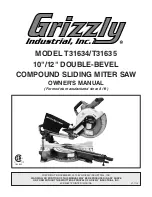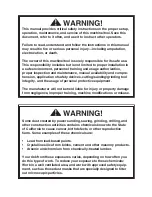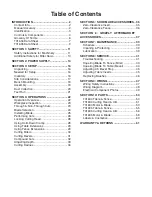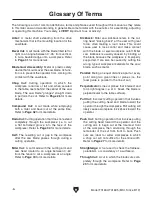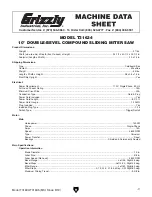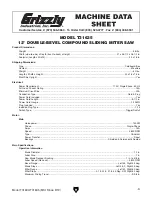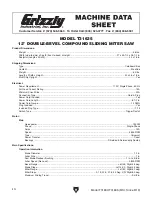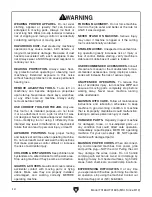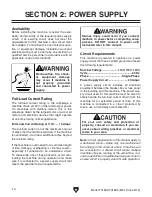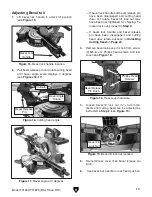
-6-
Model T31634/T31635 (Mfd. Since 8/19)
Glossary Of Terms
The following is a list of common definitions, terms and phrases used throughout this manual as they relate
to this miter saw and woodworking in general. Become familiar with these terms for assembling, adjusting
or operating this machine. Your safety is
VERY important to us at Grizzly!
Arbor: A metal shaft extending from the drive
mechanism that is the mounting location for the
saw blade.
Bevel Cut: A cut made with the blade tilted left or
right to an angle between 0˚-45˚ from vertical,
to cut a beveled edge onto a workpiece. Refer
to
Page 31 for more details.
Blade Guard Assembly: Metal or plastic safety
device that mounts over the saw blade. Its func-
tion is to prevent the operator from coming into
contact with the saw blade.
Chop Cut: Cutting operation in which the
workpiece is narrow or tall and, when secured
to the table, rests behind the center of the saw
blade. The saw blade "plunges" straight down
to perform the cut. Refer to
Page 26 for more
details.
Compound Cut: A cut made while employing
both a miter and bevel cut at the same time.
Refer to
Page 32 for more details.
Dado Cut: Cutting operation that does not extend
completely through the workpiece (i.e. to cut
a flat bottomed groove into the face of the
workpiece). Refer to
Page 34 for more details.
Kerf: The resulting cut or gap in the workpiece
after the saw blade passes through during a
cutting operation.
Miter Cut: A cut made with the cutting arm and
saw head rotated to an angle between 0˚-60˚
from the fence to cut a workpiece at an angle.
Refer to
Page 30 for more details.
Kickback: Miter saw kickback refers to the cut-
ting head "kicking back" at the user with great
force, often making a loud noise. This could
cause user to lose control and make contact
with the blade or eject workpiece cutoff. Miter
saw kickback is usually caused by binding at
the blade because the workpiece is improperly
supported. It can also be caused by cutting the
wrong type of workpiece materials for the saw/
blade, such as metal.
Parallel: Being an equal distance apart at every
point along two given lines or planes (i.e. the
laser guide is parallel to the line of cut).
Perpendicular: Lines or planes that intersect and
form right angles (i.e. at 0˚ bevel, the blade is
perpendicular to the table surface).
Pull Cut: Incorrect cutting operation that involves
pulling the cutting head and blade toward the
operator through the workpiece. Pull cutting will
likely cause a workpiece to kickback toward the
operator.
Push Cut: Cutting operation that involves pulling
the cutting head toward the operator and the
cutting arm to begin cut at the foremost front
of the workpiece, then advancing through the
remainder of the cut from front to back. Push
cuts are ideal for wider workpieces in which
a chop cut will not suffice for the entire width.
Refer to
Page 27 for more details.
Straightedge: A tool used to check the flatness,
parallelism, or consistency of a surface(s).
Through Cut: A cut in which the blade cuts com-
pletely through the workpiece. Refer to
Page
23 for more details.
Содержание T31634
Страница 64: ......

